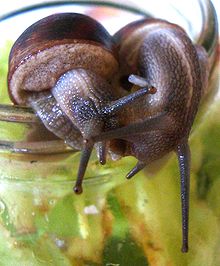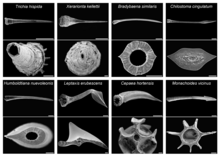Love arrow

The love arrow ( Gypsobelum ) is formed in many terrestrial snail groups in the genital system and plays an important role in mating. The term love arrow points to the arrows of Eros or Cupid in Greek and Roman mythology of antiquity .
The love arrow is formed in the arrow sack ( bursa telae ) in the genital apparatus of the snail. Land snails (Stylommatophora) are hermaphrodites that have a highly developed genital system with male, female and hermaphrodite parts. The arrow sack belongs to the female part of the genital apparatus; it opens into the vaginal canal near the finger-shaped glands.
application
The love arrow sits on a papilla inside the arrow sack. During the pairing prelude ("love game") of the snail , the arrow sack is everted through the genital atrium, the love arrow is ejected and stabbed in the partner's foot. Despite the term love arrow, or English "love dart", the love arrow does not describe a trajectory, so it is neither shot nor thrown, but pushed like a lance. When using the love arrow, it can happen that the love arrow is either not pierced correctly and simply remains inoperative or that injuries occur in which a snail that is hit in the head area by the love arrow can no longer stretch out a feeler.
function

D = love arrow
S = arrow sack ( bursa telae )
BC = bursa copulatrix
SP = seminal pouch
P = penis
V = vagina
SO = spermoviduct
G = genital
atrium MG = finger-shaped glands
Initially, it was only assumed that the love arrow would play a sexually stimulating role during the snail's love game, since after its use the love game would continue with increasing intensity. Later hypotheses assumed, for example, that the love arrow represented a lime gift to the recipient snail, which, for example, helped in the production of the lime-containing eggshells. However, since the 1980s, recent research has shown that the role of the love arrow is very different. The love arrow transmits a hormone-containing secretion from the nearby finger-shaped glands, which affects the genital apparatus of the recipient snail . The so-called bursa copulatrix is an organ of the genital system that digests foreign sperm and thus leads to the selection of the most active and healthiest sperm. The secretion of the finger-shaped glands increases the peristaltic movement of the egg ladder (spermoviduct) and thus supports the movement of the sperm cells through the egg ladder to the sperm pocket, in which they are stored until fertilization . As a result, after using a love arrow, the amount of surviving sperm can double.
A love arrow does not have to be used with every pairing. Each love arrow sack (some groups of snails, e.g. the leaf snails (Hygromiidae) and the bush snails ( Bradybaenidae) have several arrow sacks) only makes one love arrow, so that a time then elapses before a love arrow can be used again when mating. In addition, the first pairings of a young snail must first stimulate the formation of a love arrow.
to form

The shapes of the love arrow in land snails are very diverse. The love arrow is highly species-specific, so that closely related species, such as As white-lipped snail ( Cepaea hortensis ) and grove snail ( Cepaea nemoralis ) often based can distinguish their love arrow. While the love arrows of some species are just like a lance (z. B. trochulus hispidus , Trichia hispida ), so there are other types of saber-like curved love arrows (z. B. tree snail , Arianta arbustorum ) and even tortuous love arrows (z. B. Incarnate snail , Monachoides incarnatus ). The size of the love arrow is also very variable, ranging from 1 mm for the smallest to 30 mm for the largest snail species. The Roman snail's love arrow ( Helix pomatia ) is between 7 and 11 mm long. At the blunt end it has a crown, with which it sticks on the papilla of the arrow sack, as well as four longitudinal side blades, which z. B. in Cepaea hortensis are further intensified.
In most species, the love arrow is made of lime ( calcium carbonate ), in some also of chitin or cartilage .
Individual evidence
- ↑ R. Chase, KC Blanchard: The snail's love-dart delivers mucus to increase paternity. In: Proc Biol Sci. 273 (1593), 2006 Jun 22, pp. 1471-1475.
- ↑ DJD Chung: Molluscan 'Love darts'? In: Hawaiian Shell News. 1986 May, Vol 34 (5), pp 3-4.

